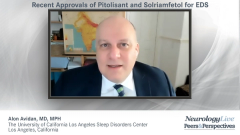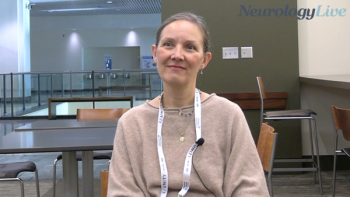
Recent Approvals of Pitolisant and Solriamfetol for EDS
Experts in neurology review the recent approvals of pitolisant and solriamfetol for the management of excessive daytime sleepiness (EDS) and compare their mechanisms of action.
Episodes in this series

Phyllis Zee, MD, PhD: Let’s talk a bit about the newer MOAs [mechanisms of action]. Tell me a bit about what you think is interesting about the new mechanisms of action with the newer medications that have been recently approved.
Alon Avidan, MD, MPH: As you correctly said, Dr Zee, having the new approval of a drug for children over age 7 using sodium oxybate is exciting. That is a group of patients about whom we do not often talk because there were no treatments in sleep medicine for children until recently. This is a forgotten group, in a way. In terms of the mechanism of action, it is exciting. Whenever we hear about a new drug in sleep medicine, that certainly is different from what we are used to. It is different from a treatment that is focused on enhancing the alertness by increasing epinephrine or dopamine-like type mechanisms or a drug that improves sleep by working as a hypnotic, in the case of sodium oxybate.
One of the newest agents on the block is pitolisant. Pitolisant has a unique mechanism of action in that it works on histamine. It blocks the H2 receptors from inhibiting their own release and synthesis. It is a fascinating mechanism of action; it is an inverse agonist at its own receptors. Histamine, as most of you know, is a wake-promoting neurotransmitter. You all know it because, when you are taking an antihistamine, you feel tired. Histamine gets released during the nighttime, and when we are using an antihistamine, we are blocking it, so we can sleep a bit longer. Histamine during the day is important, as we talked about with narcolepsy, because being able to promote histamine by blocking the inhibition of histamine release from the CNS [central nervous system] would allow histamine to be more alerting. It is an interesting mechanism of action.
In addition, we all talk about the promotion of alertness through working on dopamine and adrenaline, but when we are talking about histamine release, it would allow the patient to have improved daytime sleepiness during the day, and it also has a good effect on cataplexy. Pitolisant now has efficacy not only for excessive daytime sleepiness in the setting of narcolepsy but for the management of cataplexy as well. Unlike sodium oxybate, it is a drug that is available to be taken in the morning. Unlike the other agents, it is not a controlled substance, which is somewhat of an advantage for a lot of patients. That is the unique attribute on pitolisant. It was initially studied and developed in Europe, and it made its way to the United States, and the more recent approval is indeed for cataplexy.
Phyllis Zee, MD, PhD: It is fascinating that pitolisant is the first to be approved in this class of what we call the histamine H3 receptor inverse agonists, which then really becomes an agonist. It then increases and probably also helps stabilize wakefulness during the day together with orexin and some of the other agents, so it is pretty exciting. As you said, it is approved for the treatment of both excessive daytime sleepiness and cataplexy in patients with narcolepsy.
What is also interesting about this new mechanism of action is that, as you said, it is not scheduled. It is not a scheduled medication in our pharmacological armamentarium. I do not remember if this is exactly accurate, so remind me, but I think some of the trials were done in conjunction with other medications. Pitolisant was given and can be used in conjunction with some of the other medications. Of course, there are known safety concerns, such as the QT interval with these other areas. Safety is still something that we always try to think about with our medications.
Alon Avidan, MD, MPH: Absolutely. If I may say, especially as we are managing patients across the life cycle, the 3 medications that we need to be particularly mindful of are those that can influence the cytochrome P450 in the liver because they can potentially render oral contraceptives ineffective. Those drugs include modafinil, armodafinil, as well as pitolisant. Those are agents one may need to have a bit more review, particularly in women of childbearing age. If the patient is using these medications, then they should be considering a barrier method of contraception. That is critical.
The other thing that is unique about pitolisant, as you mentioned, is the prolongation of QT wave in the ECG [electrocardiogram]. As a general rule, I like to order ECGs whenever I place patients on stimulants. With pitolisant, it reminds me that, if a patient reports a history of arrhythmias or a family history of 1 of the more congenital cardiac arrhythmias, then getting an ECG is probably a good idea. Particularly because if the patient is using an antidepressant in addition to pitolisant, there may be some underlying facilitation of arrhythmias. That has not been demonstrated or studied well, but one has to be mindful of drug-drug interaction in that capacity.
Phyllis Zee, MD, PhD: Yes, that is a good idea. I have not systematically done ECGs in my patients. Certainly, for the amphetamine-like treatments, that has been recommended as something to follow up on. I have not done that, but it is a good thought to have.
In the last year or so, solriamfetol is another recently approved medication for the treatment of mainly excessive daytime sleepiness in patients with narcolepsy and obstructive sleep apnea. But it does not have effect on cataplexy, correct?
Alon Avidan, MD, MPH: Correct. Exactly. Solriamfetol is a dual-acting specific dopamine and norepinephrine reactive inhibitor, and we have seen some other agents that probably have a dopamine-type mechanism of action, which is perhaps related to how modafinil or armodafinil work, potentially. As you said, its action improves daytime sleepiness in the setting of narcolepsy as well as obstructive sleep apnea. We have seen the latter indication also being applied for modafinil or armodafinil, but it is a unique mechanism. It is yet another drug that can be used, particularly in the morning.
As you know, Dr Zee, when we are treating insomnia, it is hard to know who is going to respond to what. In some individuals, I have tried both. I have tried solriamfetol, and I have tried sodium oxybate. After a while, you find that a patient is responsive to drugs that you would not have predicted would work for them. It is nice to have that extra ability to move across this agent. More important, as you said, this is particularly so when you have clinical data on medications when added in combination as dual therapy as is the case of pitolisant and sodium oxybate, for example, and it demonstrates that the pharmacokinetic properties are not being impacted. That is an advantage.
We often use combination therapy in an on-demand fashion by putting patients on a wake-promoting agent or an agent to promote alertness in the morning, and we then give them a medication to enhance alertness strategically during the daytime. You can also potentially use this combination of therapy where you are keeping the dose of both agents low enough to not promote or to reduce the onset of agitation or anxiety.
Phyllis Zee, MD, PhD: It is about balancing the adverse effects because the higher the dose, then the more adverse effects there are. With timing, I let my patients determine when they are going to take some of these medications after some time because it is aimed at function, whatever their function is.
Thank you for watching this NeurologyLive® Peers & Perspectives® program. Please subscribe to the e-newsletter to receive upcoming Peer Exchanges® and other great content in your in-box.
Newsletter
Keep your finger on the pulse of neurology—subscribe to NeurologyLive for expert interviews, new data, and breakthrough treatment updates.











































